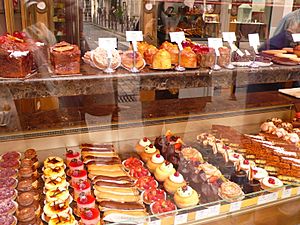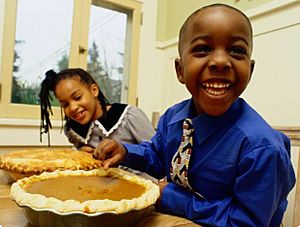Pastry facts for kids
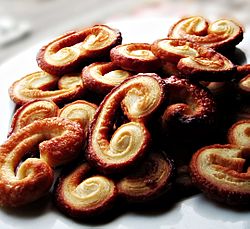
Palmier pastries
|
|
| Main ingredients | Often flour, sugar, milk, butter or shortening, baking powder, eggs |
|---|---|
Pastry is a special kind of dough used to make many yummy baked treats. This dough is usually rolled out thin. It forms the base for delicious foods like pies, tarts, and quiches. Pastry dough is made from simple ingredients. These include flour, sugar, milk, butter, or a type of fat called shortening. It can also contain baking powder and eggs.
The word "pastry" also refers to the baked goods themselves. Think of small cakes, tarts, and other sweet or savoury snacks. These are all called "pastries."
Contents
Types of Pastry Dough
There are different kinds of pastry dough, each with its own special texture.
Choux Pastry
Choux pastry is light and airy. It starts with a mix of milk or water and butter, heated until the butter melts. Then, flour is added to make a dough. Eggs are mixed in to make it even richer.
This dough has a lot of water. When it bakes, the water turns into steam. This steam makes the pastry puff up and become hollow inside. After baking, a small hole is made to let the steam out. Then, it's baked again to get crispy. Choux pastries are often filled with cream and topped with chocolate. You can also fill them with cheese or chicken for a savoury snack.
Tools and Terms for Pastry Making
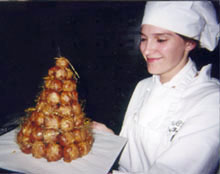
When you make pastries, you might hear some special words or use certain tools. Here are a few:
- Pastry: This can mean the dough itself, or a baked food like a pie or strudel.
- Pastry bag or piping bag: This is a cone-shaped bag. It helps you squeeze out dough, frosting, or fillings smoothly. You can use it to decorate cakes or fill pastries.
- Pastry board: A flat surface, usually wood or marble, where you roll out pastry dough.
- Pastry case: This is an empty pastry shell. It can be baked or unbaked. You fill it with sweet or savoury mixtures.
- Pastry cream: A sweet, thick cream used as a filling. It's made with milk, sugar, eggs, and flour. The flour stops the eggs from curdling.
- Pastry cutters: These are metal or plastic shapes. They have a sharp edge to cut out cookies, scones, or pastry shapes.
- Pastry blender: A kitchen tool with wires or blades. It helps mix fat into flour. This keeps the fat from melting and makes the pastry flaky.
- Viennoiserie: A French term for "Viennese pastry." It often refers to flaky pastries like croissants, brioche, and pain au chocolat.
The Science of Pastry
Making different pastries depends on how wheat flour and fats work together. When you mix wheat flour with water and knead it, it forms gluten. Gluten makes bread chewy and stretchy. But for pastry, you usually want it to be tender, not tough.
To make pastry tender, fat or oil is added. This slows down the gluten from forming too much. You can also use special pastry flour, which has less protein than regular flour.
Fats like lard or suet work well. They have a coarse, crystal-like structure. This helps create a flaky texture. Regular butter has water in it, which can make pastry less tender. Clarified butter, which has almost no water, works better. If you melt the fat or use liquid oil, the pastry might become tougher. This is because the oil creates a thin layer that doesn't stop gluten as well.
A Brief History of Pastry
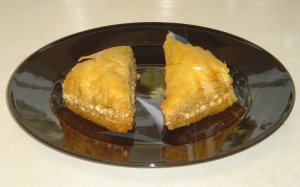
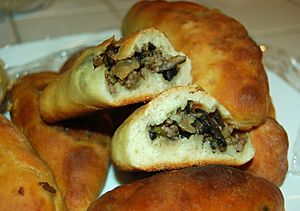
Pastry-making has a long history, going back to ancient times. In the ancient Mediterranean, people like the Romans, Greeks, and Phoenicians made thin, flaky doughs similar to phyllo pastry. There's also evidence that ancient Egyptians made pastry-like sweets. They would dip baked flour cakes in honey and add nuts.
In ancient Greece, around 500 BC, plays mentioned small pastries filled with fruit. The Romans used pastry dough to cover meats and birds while baking. This kept the juices in, but the pastry itself wasn't usually eaten. However, they also made richer pastries with eggs or small birds, often served at big meals. Both Greeks and Romans found it hard to make stiff pastries because they used oil, which made the dough less firm.
In medieval Northern Europe, chefs learned to make nice, stiff pastries using butter and other fats. Old cookbooks from that time mention ingredients, but not full recipes. There were tough, empty pastries called "coffins" or 'huff paste'. These were mostly eaten by servants. They sometimes had an egg yolk glaze to make them taste better. Small tarts were also part of medieval pastries.
Real pastry recipes started appearing around the mid-1500s. These recipes spread across Europe. This led to many different pastry traditions, from Portuguese "pastéis de nata" to Russian "pirozhki". Chocolate became common in Western pastries only after Spanish and Portuguese traders brought it from the New World in the 16th century. Many food historians believe French chef Antonin Carême (1784–1833) was the first great master of modern pastry making.
Pastry-making is also very important in many parts of Asia. Chinese pastry is often made from rice or different flours. It can have fillings like fruit, sweet bean paste, or sesame. Mooncakes are a big part of the Chinese Mid-Autumn Festival. Cha siu bao, which are steamed or baked pork buns, are popular dim sum items. In the 1800s, the British brought Western-style pastry to Asia. Later, in the 1950s, a French-influenced company in Hong Kong helped make Western pastry popular in Chinese-speaking areas. Other Asian countries, like Korea and Japan, have their own unique traditional sweets. These include tteok, hangwa, yaksik, mochi, and manjū. Asian pastries are often less sweet than Western ones.
Pastry Chefs
Pastry chefs are like artists in the kitchen. They use their cooking skills and creativity to bake, decorate, and flavor delicious desserts. Making many baked goods takes a lot of time and focus. How a pastry looks is very important.
Being a pastry chef can be physically demanding. It requires great attention to detail and often long hours. Pastry chefs also create new recipes for menus. They work in restaurants, hotels, casinos, and bakeries. The pastry section of a kitchen is usually a bit separate from where the main meals are cooked. This area focuses on making all the wonderful pastries, desserts, and other baked treats.
Gallery
-
Cream puff pastry, Dutch Moorkoppen
-
Tompouce, a Dutch and Belgian pastry
-
English pork pie topped with red currants
-
Argentine sweet pionono
-
Slice of Argentine sweet pionono
-
Crocetta of Caltanissetta of lemon, left, and orange, right
-
Pecan and maple Danish pastry, a puff pastry type
-
Profiterole or cream puff, a choux pastry
-
Pork pie on a plate
-
Blackberry pie made with a pastry crust
Images for kids
-
Swedish cinnamon rolls
-
Runeberg torte, a traditional Finnish pastry flavored with almonds and arrack (or rum)
-
Persian Zolbia and Bamieh
See also
 In Spanish: Repostería para niños
In Spanish: Repostería para niños


